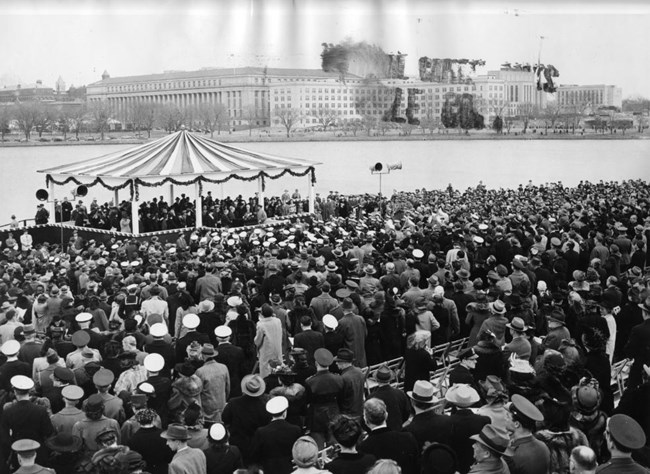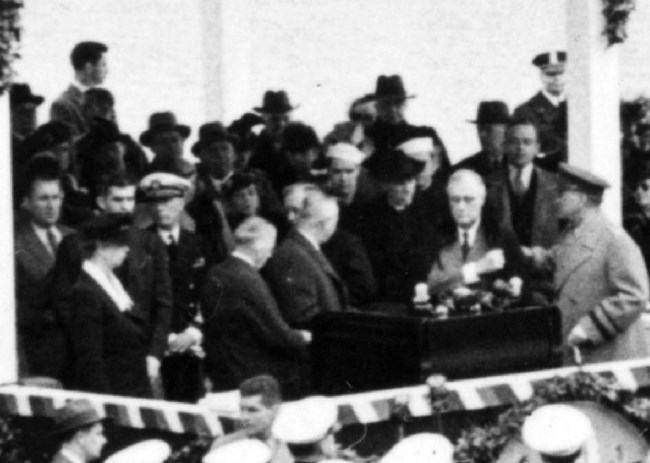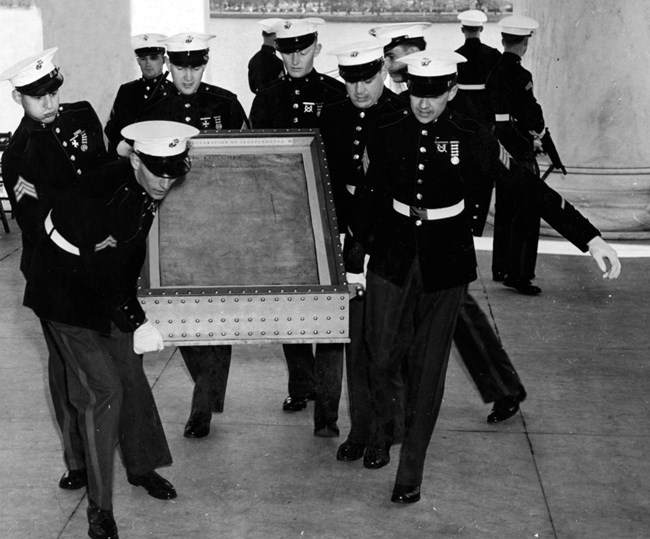Last updated: April 13, 2018
Article
Jefferson Memorial Dedication Drew Dignitaries, Declaration

Scheduled on the 200th anniversary of Jefferson’s birth, the dedication of his memorial was the culmination of nearly a decade of planning and construction. The memorial was championed to the Commission of Fine Arts by Franklin Delano Roosevelt in the second year of his presidency, and by 1935 Congress had appropriated $3 million for its construction. The groundbreaking was held three years later, and construction was substantially completed by the spring of 1943. Only the bronze statue of Jefferson had not been completed, owing to wartime metal shortages (a painted plaster version was in place for the dedication and would remain until the restrictions on metal use were lifted in 1947).
Though Roosevelt was widely expected to attend the dedication (he had spoken at both the groundbreaking in 1938 and the laying of the cornerstone the following year), his participation wasn’t announced until the morning of the ceremony.
Traveling from the White House with First Lady Eleanor Roosevelt, former First Lady Lou Hoover and Crown Princess Martha of Norway, the president and his party arrived at the memorial just prior to the start of the noon ceremony. Some 5,000 spectators (including Wendell Willkie, FDR’s Republican opponent in the 1940 presidential election and a who’s who of the international diplomatic corps) were assembled on the plaza in front of the memorial, facing the dais, set up on the edge of the Tidal Basin and covered in red, white and blue streamers.
Under overcast and windy skies with a backdrop of the fading cherry trees (peak bloom had been reached on April 4 that year) the ceremony began with remarks by Stuart Gibboney, chairman of the Jefferson Memorial Commission, followed by the invocation from the Right. Rev. Henry St. George Tucker, presiding bishop of the Episcopal Church in America.

President Roosevelt then approached the podium to deliver the dedication address. Calling the memorial a “shrine to freedom” and adding that it was a payment on “a debt long overdue,” FDR took the opportunity to remind those in attendance (and listening via radio across the country), of the parallels between Thomas Jefferson’s challenges in the founding of the republic, and those being experienced at the time by a nation embroiled in a world war:
“He faced the fact that men who will not fight for liberty can lose it. We, too, have faced that fact.
"He lived in a world in which freedom of conscience and freedom of mind were battles still to be fought through—not principles already accepted of all men. We, too, have lived in such a world.
"He loved peace and loved liberty—yet on more than one occasion he was forced to choose between them. We, too, have been compelled to make that choice.”
"He lived in a world in which freedom of conscience and freedom of mind were battles still to be fought through—not principles already accepted of all men. We, too, have lived in such a world.
"He loved peace and loved liberty—yet on more than one occasion he was forced to choose between them. We, too, have been compelled to make that choice.”
The requested video is no longer available.

Those who ventured into the memorial chamber found not only the 19-foot tall plaster statue of Jefferson, but also the original, handwritten version of the Declaration of Independence signed by the delegates (known as the “engrossed copy”), the same one seen today in the Rotunda of the National Archives. Not only was the Jefferson’s masterwork on display, but in a story line that would not have been out of place in National Treasure, it had come to the memorial from what was described at the time only as “a secret place of safekeeping.”
Shortly after the attack on Pearl Harbor, thousands of America’s most valuable documents in the care of the Library of Congress – including the engrossed copy of the Declaration of Independence, the U.S. Constitution, a copy of the Magna Carta, and a Guttenberg Bible – were evacuated from Washington in case of attack by the Axis powers. While we know today that they were held at the Bullion Depository in Fort Knox, Kentucky, at the time their destination was a wartime secret, “guarded as carefully of the movements of troops,” according to a contemporary account by United Press International.
On April 7, 1943, it was announced that the Declaration of Independence had been removed from its “wartime hiding place,” and would be exhibited in Washington for the opening of the memorial and for a few days afterward, albeit in a steel, lead and bulletproof glass case under 24-hour guard of the U.S. Marine Corps. Having been exhibited at the foot of Jefferson’s statue and viewed by thousands for those first few days the memorial was open, the Declaration of Independence was returned to Fort Knox, where it would remain until 1944, when military authorities assured the Library of Congress that the danger of attack had passed. It was returned to Washington and put back on display on October 1 of that year.
